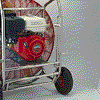|
E |
|
Envelope
|
 The envelope is the part of the balloon that inflates. It is made up of a number of gores, which are themselves made up of a number of smaller panels. Each panel edge is folded back on itself, interleaved with the next folded edge, and then all four thicknesses of fabric are sewn through twice by machine using a lockstitch. The gores are attached to heavy duty nylon tapes that pass around the balloon. The envelope has large holes top and bottom. The bottom one is fairly obvious in its function - the pilot has to be able to fill the balloon with hot air. The top one is a valve to enable the pilot to vent air quickly when the pilot wants to descend or land. Envelopes are named by their capacity. For example a '77' holds 77,000 cubic feet of air. This is about the size of balloon that will carry four people. The envelope is the part of the balloon that inflates. It is made up of a number of gores, which are themselves made up of a number of smaller panels. Each panel edge is folded back on itself, interleaved with the next folded edge, and then all four thicknesses of fabric are sewn through twice by machine using a lockstitch. The gores are attached to heavy duty nylon tapes that pass around the balloon. The envelope has large holes top and bottom. The bottom one is fairly obvious in its function - the pilot has to be able to fill the balloon with hot air. The top one is a valve to enable the pilot to vent air quickly when the pilot wants to descend or land. Envelopes are named by their capacity. For example a '77' holds 77,000 cubic feet of air. This is about the size of balloon that will carry four people.
|
|
Envelope Scoop
|
This is the small conical section of cloth that hangs from below the main envelope and runs halfway around the envelope. Its purpose is to direct the hot air into the main envelope and protect the jet from the prevailing breeze.
|
|
F |
|
Fabric
|
The fabric that is used to make hot-air balloons is known as ripstop nylon. It is specially woven with crisscross reinforcement threads to help prevent tearing. The fabric is lightweight and colourful and can withstand temperatures in excess of 120 degrees C - well above the boiling point of water.
|
|
Fuel Tanks
|
The fuel tanks or cylinders are tanks of liquid propane gas. They normally stand in the corner of the basket leaving room for the pilot and passengers. Padded covers surround the cylinder - just in case of a bumpy landing - while rubber encased armoured pipes carry the fuel up to the burner which is supported above the basket on flexible nylon rods. Fuel tanks are now available from Cameronís made out of titanium which offers a significant weight saving.
|
|
I |
|
Inflator Fan
|
 Shooting jets of flame sideways into an empty envelope doesn't tend to do it any good, and so the initial inflation of the envelope is done with an inflator fan. They may have either three bladed or four bladed fans to improve their efficiency, and they come in a range of power depending on the size of envelope that needs to be filled. Shooting jets of flame sideways into an empty envelope doesn't tend to do it any good, and so the initial inflation of the envelope is done with an inflator fan. They may have either three bladed or four bladed fans to improve their efficiency, and they come in a range of power depending on the size of envelope that needs to be filled.
|
|
Instruments
|
Pilots carry a variety of instruments, and one of the most important of these may be the GPS (Global Positioning System). This uses satellite transmissions to pinpoint exactly where the balloon is to an accuracy of within 100 metres. Wind instruments and an altimeter are clearly important as well.
|